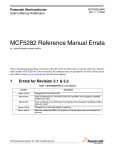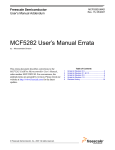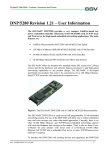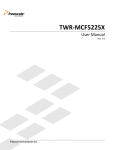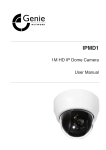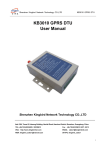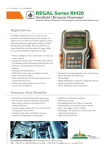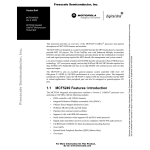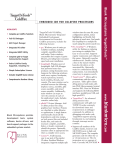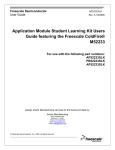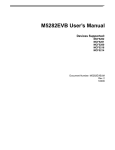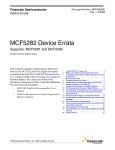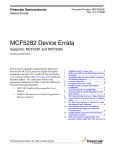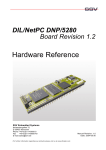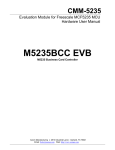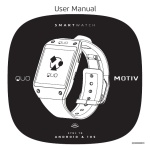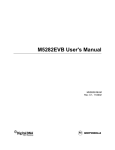Download The DatasheetArchive - Datasheet Search Engine - DIS-TEC
Transcript
Freescale Semiconductor User’s Manual Addendum MCF5282UMAD Rev. 8, 01/2005 MCF5282 User’s Manual Errata by: 32-bit Embedded Controller Division This errata document describes corrections to the MCF5282 ColdFire Microcontroller User’s Manual, order number MCF5282UM. For convenience, the addenda items are grouped by revision. Please check our website at http://www.freescale.com for the latest updates. 1 Errata for Revision 2.3 Table 1. MCF5282UM Rev 2.3 Errata Location Table 9-4/9-7 Description In the table for MFD bit definition, footnote (1) equation should read: f ref × 2 ( MFD + 2 ) f sys = --------------------------------------------- ; f ref × 2 ( MFD + 2 ) ≤ f sys ( max ) ; fsys ≤ f sys ( max ) RFD 2 Where fsys(max) is the maximum system frequency for the particular MCF5282 device (66MHz or 80MHz) Chapter 17 The maximum buffer size of the FEC is 2032 bytes. Replace any mention of the max size being 2047 bytes with 2032 bytes. © Freescale Semiconductor, Inc., 2004. All rights reserved. Errata for Revision 2.1 & 2.2 Table 1. MCF5282UM Rev 2.3 Errata (continued) Location Description Chapter 33 Add the following note: It is crucial during power-up that VDD never exceeds VDDH by more that ~0.3V. There are diode devices between the two voltage domains, and violating this rule can lead to a latch-up condition. Table 33-8/33-7 In the PLL Electrical Specifications table, only specs for the 80MHz MCF5282 device were listed. Insert specs for the 66MHz device in the first 2 rows and also declare symbol fsys(max), as shown below: Max Characteristic Symbol PLL Reference Frequency Range Crystal reference fref_crystal External reference fref_ext fref_1:1 1:1 Mode System Frequency 1 External Clock Mode On-Chip PLL Frequency 2 Min Unit 66MHz 80MHz 8.33 8.33 66.66 10.0 10.0 80 MHz 2 2 33.33 fsys 0 fref / 32 fsys(max) fsys(max) MHz 66.66 80 66.66 80 Errata for Revision 2.1 & 2.2 Table 2. MCF5282UM Rev 2.1 & 2.2 Errata Location Description Figure 4-2/4-6 Changed bit 23 from DIDI to DISI Table 4-6/4-9 Under ‘Configuration’ for ‘Instruction Cache’ the ‘Operation’ entry changed to “Invalidate 2 KByte data cache” Table 4-6/4-9 Under ‘Configuration’ for ‘Data Cache’ the ‘Operation’ entry changed to “Invalidate 2 KByte instruction cache” Figure 6-3/6-6 Changed bit 8 to write-only instead of read/write Table 6-10/6-15 Table 9-4/9-7 Removed “selected by BKSL[1:0]” as these are internal signal names not necessary for end-user. In the table for MFD bit definition, footnote (1) equation should read: f ref × 2 ( MFD + 2 ) f sys = --------------------------------------------- ; f ref × 2 ( MFD + 2 ) ≤ f sys ( max ) ; fsys ≤ f sys ( max ) RFD 2 Where fsys(max) is the maximum system frequency for the particular MCF5282 device (66MHz or 80MHz) MCF5282 User’s Manual Errata, Rev. 8 2 Freescale Semiconductor Errata for Revision 2.1 & 2.2 Table 2. MCF5282UM Rev 2.1 & 2.2 Errata (continued) Location Description 10.3.2/10-8 Add the following note: ‘If an interrupt source is being masked in the interrupt controller mask register (IMR) or a module’s interrupt mask register while the interrupt mask in the status register (SR[I]) is set to a value lower than the interrupt’s level, a spurious interrupt may occur. This is because by the time the status register acknowledges this interrupt, the interrupt has been masked. A spurious interrupt is generated because the CPU cannot determine the interrupt source. To avoid this situation for interrupts sources with levels 1-6, first write a higher level interrupt mask to the status register, before setting the mask in the IMR or the module’s interrupt mask register. After the mask is set, return the interrupt mask in the status register to its previous value. Since level seven interrupts cannot be disabled in the status register prior to masking, use of the IMR or module interrupt mask registers to disable level seven interrupts is not recommended.’ Chapter 17 The maximum buffer size of the FEC is 2032 bytes. Replace any mention of the max size being 2047 bytes with 2032 bytes. Table 17-2/17-5 Figure 17-23/17-39 25.4.10/25-16 In PALR/PAUR entry, delete “(only needed for full duplex flow control)” Change FRSR to read/write instead of read-only. Change CANICR to ICRn. Table 25-17/25-29 Add the following information to BITERR and ACKERR descriptions: “To clear this bit, first read it as a one, then write it as a one. Writing zero has no effect.” Table 25-17/25-30 Change bit ordering: ERRINT should be bit 2 and BOFFINT should be bit 1. Table 25-19/25-32 Change BUFnI field description from “To clear an interrupt flag, first read the flag as a one, then write it as a zero” to “To clear an interrupt flag, first read the flag as a one, then write it as a one.” Chapter 33 It is crucial during power-up that VDD never exceeds VDDH by more that ~0.3V. There are diode devices between the two voltage domains, and violating this rule can lead to a latch-up condition. Table 33-8/33-7 In the PLL Electrical Specifications table, only specs for the 80MHz MCF5282 device were listed. Insert specs for the 66MHz device in the first 2 rows and also declare symbol fsys(max), as shown below: Max Characteristic Symbol PLL Reference Frequency Range Crystal reference fref_crystal fref_ext External reference fref_1:1 1:1 Mode System Frequency 1 External Clock Mode On-Chip PLL Frequency Min Unit 66MHz 80MHz 8.33 8.33 66.66 10.0 10.0 80 MHz 2 2 33.33 fsys 0 fref / 32 fsys(max) fsys(max) MHz 66.66 80 66.66 80 MCF5282 User’s Manual Errata, Rev. 8 Freescale Semiconductor 3 Errata for Revision 2.0 3 Errata for Revision 2.0 Table 3. MCF5282UM Rev 2.0 Errata Location Table 33-8/33-9 4 Description Reference to ‘TA = TL to TH’ was not deleted. Delete. Errata for Revision 1.0 Table 4. MCF5282UM Rev 1.0 Errata Location 1.1/1-1 Description Change ‘Real time debug support, with two user-visible hardware breakpoint registers’ To ‘Real time debug support, with one user-visible hardware breakpoint register’ Table 2-2/2-7 Change the I field description to read: “Interrupt level mask. Defines the current interrupt level. Interrupt requests are inhibited for all priority levels less than or equal to the current level, except the edge-sensitive level 7 request, which cannot be masked.” Table 5-1/5-2 Replace the description of PRI1 and PRI2 with the following: Description Priority bit. PRI1 determines if DMA or CPU has priority in upper 32K bank of memory. PRI2 determines if DMA or CPU has priority in lower 32K bank of memory. If bit is set, DMA has priority. If bit is reset, CPU has priority. Priority is determined according to the following table. PRI[1:2] Upper Bank Priority Lower Bank Priority 00 01 10 11 DMA Accesses DMA Accesses CPU Accesses CPU Accesses DMA Accesses CPU Accesses DMA Accesses CPU Accesses NOTE: The Motorola-recommended setting for the priority bits is 00. Table 5-1/5-3 Add the following note to the SPV bit description: “The BDE bit in the second RAMBAR register must also be set to allow dual port access to the SRAM. For more information, see Section 8.4.2, ‘Memory Base Address Register (RAMBAR).’” MCF5282 User’s Manual Errata, Rev. 8 4 Freescale Semiconductor Errata for Revision 1.0 Table 4. MCF5282UM Rev 1.0 Errata (continued) Location Figure 6-2/6-4 Description Replace Figure 6-2, “CFM 512K Array Memory Map,” with the figure below. Logical Block 1 (256 Kbytes) 0x0007 FFFF Flash Physical Block 2 0x0004 000C 3H[1] 3L[1] 0x0004 0008 2H[1] 2L[1] 0x0004 0004 3H[0] 3L[0] 0x0004 0000 2H[0] 2L[0] Flash Physical Block 3 2H[31] 2L[31] 3H[31] 3L[31] Memory Array 2H Memory Array 2L Memory Array 3H Memory Array 3L 2H[0] 2L[0] 3H[0] 3L[0] 0x0003 FFFF Logical Block 0 (256 Kbytes) Flash Physical Block 0 Configuration Field (0x0000_0400– 0x0000_0417) 0x0000 000C 1H[1] 1L[1] 0x0000 0008 0H[1] 0L[1] 0x0000 0004 1H[1] 1L[1] 0x0000 0000 0H[0] 0L[0] Flash Physical Block 1 0H[31] 0L[31] 1H[31] 1L[31] Memory Array 0H Memory Array 0L Memory Array 1H Memory Array 1L 0H[0] 0L[0] 1H[0] 1L[0] Each memory array = 64 Kbytes (16 bits wide × 32K) Each physical block = 128 Kbytes (32 bits wide × 32K) Figure 6-2. CFM 512K Array Memory Map Table 6-12/6-16 Change value for page erase verify command to 0x06. Table 6-13/6-20 Change value for page erase verify command to 0x06. Table 8-3/8-5 Add the following note the BDE bit description: “The SPV bit in the CPU’s RAMBAR must also be set to allow dual port access to the SRAM. For more information, see Section 5.3.1, ‘SRAM Base Address Register (RAMBAR).’” Figure 9-1/9-3 Remove ÷ 2 from CLKGEN block. 10.3.6/10-11 Add this text to the end of the first paragraph: “If a specific interrupt request is completely unused, the ICRnx value can remain in its reset (and disabled) state.” 10.5/10-17 Add the following note: “The wakeup mask level taken from LPICR[6:4] is adjusted by hardware to allow a level 7 IRQ to generate a wakeup. That is, the wakeup mask value used by the interrupt controller must be in the range of 0–6.” Figure 12-4/12-8 13.5/13-15 Change CSCRn to reflect that AA is set to ‘1’ at reset. Remove final paragraph. The paragraph incorrectly states that the MCF5282 does not have a bus monitor. MCF5282 User’s Manual Errata, Rev. 8 Freescale Semiconductor 5 Errata for Revision 1.0 Table 4. MCF5282UM Rev 1.0 Errata (continued) Location Table 17-13/17-26 Description Change encodings for bits 31–9 to: 0The corresponding interrupt source is masked. 1The corresponding interrupt source is not masked. Chapter 19 Change PIT1–PIT4 to PIT0–PIT3 throughout chapter. When a timer is referenced individually, PIT1 should be PIT0, PIT2 should be PIT1, PIT3 should be PIT2, and PIT4 should be PIT3. Other chapters in the user’s manual use the correct nomenclature: PIT0–PIT3. 19.6.3/19-7 Change timeout period equation to the equation below. PRE[3:0] × (PM[15:0] + 1) × 2 Timeout period = ----------------------------------------------------------------------------system clock Figure 23-11 Change UISR bits 5–3 to reserved bits 24.6.1/24-11 Change ‘I2CR = 0xA’ to ‘I2CR = 0xA0.’ 27.2.1/27-2 Change ‘When interfacing to 16-bit ports, the port C and D pins and PJ[7:6] (BS[3:2]) can be configured as general-purpose input/output (I/O)’ To ‘When interfacing to 16-bit ports, the port C and D pins and PJ[5:4] (BS[1:0]) can be configured as general-purpose input/output (I/O)’ 32.2/32-7 Added additional device number order information to Table 32-2. Table 32-2. Orderable Part Numbers Motorola Part Number Description MCF5280CVF66 MCF5280 RISC Microprocessor, 256 MAPBGA MCF5280CVF80 MCF5280 RISC Microprocessor, 256 MAPBGA MCF5281CVF66 MCF5281 RISC Microprocessor, 256 MAPBGA MCF5281CVF80 MCF5281 RISC Microprocessor, 256 MAPBGA MCF5282CVF66 MCF5282 RISC Microprocessor, 256 MAPBGA MCF5282CVF80 MCF5282 RISC Microprocessor, 256 MAPBGA Chapter 33 Speed Temperature 66.67 MHz -40° to +85° C 80 MHz -40° to +85° C 66.67 MHz -40° to +85° C 80 MHz -40° to +85° C 66.67 MHz -40° to +85° C 80 MHz -40° to +85° C Delete references to ‘TA = TL to TH’. Table 33-1/33-1 The Digital Input Voltage (VIN) absolute maximum rating should be -0.3 to 6.0 V Table 33-6/33-8 The normal operation analog supply current (IDDA) maximum value has been changed to 5.0 mA. MCF5282 User’s Manual Errata, Rev. 8 6 Freescale Semiconductor Errata for Revision 1.0 Table 4. MCF5282UM Rev 1.0 Errata (continued) Location Description Figure 33-5/33-16 Replace Figure 33-5, ‘SDRAM Read Cycle’ with the figure below. 1 0 2 3 4 5 6 7 8 9 10 11 12 13 CLKOUT D3 D1 Row A[23:0] Column D4 SRAS D2 SCAS 1 D4 DRAMW D5 D[31:0] D6 SDRAM_CS[1:0] D4 BS[3:0] ACTV NOP NOP READ PRE 1 DACR[CASL] = 2 Figure 33-5. SDRAM Read Cycle Table 14-3/14-11 Change ‘Internal Pull-Up’ column to pull-up indications in the table below. Table 14-3. MCF5282 Signals and Pin Numbers Sorted by Function Pin Functions MAPBGA Pin Description Primary2 Secondary Tertiary Internal Primary Pull-up I/O 1 Reset R11 RSTI — — Reset in I Yes P11 RSTO — — Reset out O — External clock/crystal in I — Clock T8 EXTAL — — MCF5282 User’s Manual Errata, Rev. 8 Freescale Semiconductor 7 Errata for Revision 1.0 Table 14-3. MCF5282 Signals and Pin Numbers Sorted by Function (continued) Pin Functions MAPBGA Pin Internal Primary Pull-up I/O 1 Description Primary2 Secondary Tertiary R8 XTAL — — Crystal drive O — N7 CLKOUT — — Clock out O — Chip Configuration/Mode Selection R14 CLKMOD0 — — Clock mode select I Yes T14 CLKMOD1 — — Clock mode select I Yes T11 RCON — — Reset configuration enable I Yes H1 D26 PA2 — Chip mode I/O — K2 D17 PB1 — Chip mode I/O — K3 D16 PB0 — Chip mode I/O — J4 D19 PB3 — Boot device/data port size I/O — K1 D18 PB2 — Boot device/data port size I/O — J2 D21 PB5 — Output pad drive strength I/O — External Memory Interface and Ports C6:B6:A5 A[23:21] PF[7:5] CS[6:4] Address bus O Yes C4:B4:A4:B3:A3 A[20:16] PF[4:0] — Address bus O Yes A2:B1:B2:C1: C2:C3:D1:D2 A[15:8] PG[7:0] — Address bus O Yes D3:D4:E1:E2: E3:E4:F1:F2 A[7:0] PH[7:0] — Address bus O Yes F3:G1:G2:G3: G4:H1:H2:H3 D[31:24] PA[7:0] — Data bus I/O — H4:J1:J2:J3: J4:K1:K2:K3 D[23:16] PB[7:0] — Data bus I/O — L1:L2:L3:L4: M1:M2:M3:M4 D[15:8] PC[7:0] — Data bus I/O — N1:N2:N3:P1: N5:T6:R6:P6 D[7:0] PD[7:0] — Data bus I/O — P14:T15:R15:R16 BS[3:0] PJ[7:4] — Byte strobe I/O Yes N16 OE PE7 — Output enable I/O — P16 TA PE6 — Transfer acknowledge I/O Yes P15 TEA PE5 — Transfer error acknowledge I/O Yes N15 R/W PE4 — Read/write I/O Yes N14 SIZ1 PE3 SYNCA Transfer size I/O Yes3 MCF5282 User’s Manual Errata, Rev. 8 8 Freescale Semiconductor Errata for Revision 1.0 Table 14-3. MCF5282 Signals and Pin Numbers Sorted by Function (continued) Pin Functions MAPBGA Pin Description Internal Primary Pull-up I/O 1 Primary2 Secondary Tertiary M16 SIZ0 PE2 SYNCB Transfer size I/O Yes4 M15 TS PE1 SYNCA Transfer start I/O Yes M14 TIP PE0 SYNCB Transfer in progress I/O Yes Chip Selects L16:L15:L14:L13 CS[3:0] PJ[3:0] — Chip selects 3-0 I/O Yes C6:B6:A5 A[23:21] PF[7:5] CS[6:4] Chip selects 6-4 O Yes SDRAM Controller H15 SRAS PSD5 — SDRAM row address strobe I/O — H16 SCAS PSD4 — SDRAM column address strobe I/O — G15 DRAMW PSD3 — SDRAM write enable I/O — H13:G16 SDRAM_CS[1:0] PSD[2:1] — SDRAM chip selects I/O — H14 SCKE PSD0 — SDRAM clock enable I/O — External interrupt request I/O — External Interrupts Port B15:B16:C14:C15: C16: D14:D15 IRQ[7:1] PNQ[7:1] — Ethernet C10 EMDIO PAS5 URXD2 Management channel serial data I/O — B10 EMDC PAS4 UTXD2 Management channel clock I/O — A8 ETXCLK PEH7 — MAC Transmit clock I/O — D6 ETXEN PEH6 — MAC Transmit enable I/O — D7 ETXD0 PEH5 — MAC Transmit data I/O — B11 ECOL PEH4 — MAC Collision I/O — A10 ERXCLK PEH3 — MAC Receive clock I/O — C8 ERXDV PEH2 — MAC Receive enable I/O — D9 ERXD0 PEH1 — MAC Receive data I/O — A11 ECRS PEH0 — MAC Carrier sense I/O — A7:B7:C7 ETXD[3:1] PEL[7:5] — MAC Transmit data I/O — D10 ETXER PEL4 — MAC Transmit error I/O — A9:B9:C9 ERXD[3:1] PEL[3:1] — MAC Receive data I/O — B8 ERXER PEL0 — MAC Receive error I/O — MCF5282 User’s Manual Errata, Rev. 8 Freescale Semiconductor 9 Errata for Revision 1.0 Table 14-3. MCF5282 Signals and Pin Numbers Sorted by Function (continued) Pin Functions MAPBGA Pin Description Primary2 Secondary Tertiary Internal Primary Pull-up I/O 1 FlexCAN D16 CANRX PAS3 URXD2 FlexCAN Receive data I/O — E13 CANTX PAS2 UTXD2 FlexCAN Transmit data I/O — I2C E14 SDA PAS1 URXD2 I2C Serial data I/O Yes5 E15 SCL PAS0 UTXD2 I2C Serial clock I/O Yes6 QSPI F13 QSPI_DOUT PQS0 — QSPI data out I/O — E16 QSPI_DIN PQS1 — QSPI data in I/O — F14 QSPI_CLK PQS2 — QSPI clock I/O — G14:G13:F16:F15 QSPI_CS[3:0] PQS[6:3] — QSPI chip select I/O — UARTs R7 URXD1 PUA3 — U1 receive data I/O — P7 UTXD1 PUA2 — U1 transmit data I/O — N6 URXD0 PUA1 — U0 receive data I/O — T7 UTXD0 PUA0 — U0 transmit data I/O — C10 EMDIO PAS5 URXD2 U2 receive data I/O — B10 EMDC PAS4 UTXD2 U2 transmit data I/O — D16 CANRX PAS3 URXD2 U2 receive data I/O — E13 CANTX PAS2 UTXD2 U2 transmit data I/O — E14 SDA PAS1 URXD2 U2 receive data I/O Yes5 E15 SCL PAS0 UTXD2 U2 transmit data I/O Yes6 K16 DTIN3 PTC3 URTS1/ URTS0 U1/U0 Request to Send I/O — K15 DTOUT3 PTC2 URTS1/ URTS0 U1/U0 Request to Send I/O — K14 DTIN2 PTC1 UCTS1/ UCTS0 U1/U0 Clear to Send I/O — K13 DTOUT2 PTC0 UCTS1/ UCTS0 U1/U0 Clear to Send I/O — J16 DTIN1 PTD3 URTS1/ URTS0 U1/U0 Request to Send I/O — MCF5282 User’s Manual Errata, Rev. 8 10 Freescale Semiconductor Errata for Revision 1.0 Table 14-3. MCF5282 Signals and Pin Numbers Sorted by Function (continued) Pin Functions MAPBGA Pin Description Internal Primary Pull-up I/O 1 Primary2 Secondary Tertiary J15 DTOUT1 PTD2 URTS1/ URTS0 U1/U0 Request to Send I/O — J14 DTIN0 PTD1 UCTS1/ UCTS0 U1/U0 Clear to Send I/O — J13 DTOUT0 PTD0 UCTS1/ UCTS0 U1/U0 Clear to Send I/O — General Purpose Timers T13:R13:P13:N13 GPTA[3:0] PTA[3:0] — Timer A IC/OC/PAI I/O Yes T12:R12:P12:N12 GPTB[3:0] PTB[3:0] — Timer B IC/OC/PAI I/O Yes N14 SIZ1 PE3 SYNCA Timer A synchronization input I/O Yes3 M16 SIZ0 PE2 SYNCB Timer B synchronization input I/O Yes4 M15 TS PE1 SYNCA Timer A synchronization input I/O Yes M14 TIP PE0 SYNCB Timer B synchronization input I/O Yes DMA Timers K16 DTIN3 PTC3 URTS1/ URTS0 Timer 3 in I/O — K15 DTOUT3 PTC2 URTS1/ URTS0 Timer 3 out I/O — K14 DTIN2 PTC1 UCTS1/ UCTS0 Timer 2 in I/O — K13 DTOUT2 PTC0 UCTS1/ UCTS0 Timer 2 out I/O — J16 DTIN1 PTD3 URTS1/ URTS0 Timer 1 in I/O — J15 DTOUT1 PTD2 URTS1/ URTS0 Timer 1 out I/O — J14 DTIN0 PTD1 UCTS1/ UCTS0 Timer 0 in I/O — J13 DTOUT0 PTD0 UCTS1/ UCTS0 Timer 0 out I/O — Queued Analog-to-Digital Converter (QADC) T3 AN0 PQB0 ANW Analog channel 0 I/O — R2 AN1 PQB1 ANX Analog channel 1 I/O — T2 AN2 PQB2 ANY Analog channel 2 I/O — R1 AN3 PQB3 ANZ Analog channel 3 I/O — MCF5282 User’s Manual Errata, Rev. 8 Freescale Semiconductor 11 Errata for Revision 1.0 Table 14-3. MCF5282 Signals and Pin Numbers Sorted by Function (continued) Pin Functions MAPBGA Pin Internal Primary Pull-up I/O 1 Description Primary2 Secondary Tertiary R4 AN52 PQA0 MA0 Analog channel 52 I/O — T4 AN53 PQA1 MA1 Analog channel 53 I/O — P3 AN55 PQA3 ETRIG1 Analog channel 55 I/O — R3 AN56 PQA4 ETRIG2 Analog channel 56 I/O — P4 VRH — — High analog reference I — T5 VRL — — Low analog reference I — Debug and JTAG Test Port Control R9 JTAG_EN — — JTAG Enable I — P9 DSCLK TRST — Debug clock / TAP reset I Yes7 T9 TCLK — — TAP clock I Yes7 P10 BKPT TMS — Breakpoint/TAP test mode select I Yes7 R10 DSI TDI — Debug data in / TAP data in I Yes7 T10 DSO TDO — Debug data out / TAP data out O — C12:D12:A13:B13 DDATA[3:0] PDD[7:4] — Debug data I/O — C13:A14:B14:A15 PST[3:0] PDD[3:0] — Processor status data I/O — Test mode pin I — Test N10 TEST — Power Supplies R5 VDDA — — Analog positive supply I — P5:T1 VSSA — — Analog ground I — P2 VDDH — — ESD positive supply I — N8 VDDPLL — — PLL positive supply I — P8 VSSPLL — — PLL ground I — A6:C11 VPP — — Flash (stress) programming voltage I — A12:C5:D5:D11 VDDF — — Flash positive supply I — B5:B12: VSSF — — Flash module ground I — N11 VSTBY — — Standby power I — MCF5282 User’s Manual Errata, Rev. 8 12 Freescale Semiconductor Revision History Table 14-3. MCF5282 Signals and Pin Numbers Sorted by Function (continued) Pin Functions MAPBGA Pin Description Internal Primary Pull-up I/O 1 Primary2 Secondary Tertiary E6-E11:F5:F7-F10: F12:G5:G6:G11: G12:H5:H6:H11: H12:J5:J6:J11:J12: K5:K6:K11:K12:L5: L7-L10:L12: M6-M11 VDD — — Positive supply I — A1:A16:E5:E12:F6: F11:G7-G10:H7-H10: J7-J10:K7-K10:L6: L11:M5:M12:T16 VSS — — Ground I — NOTES: 1 Pull-ups are not active when GPIO functions are selected for the pins. 2 The primary functionality of a pin is not necessarily its default functionality. Pins that have GPIO functionality will default to GPIO inputs. 3 Pull-up is active only with the SYNCA function. 4 Pull-up is active only with the SYNCB function. 5 Pull-up is active only with the SDA function. 6 Pull-up is active only with SCL function. 7 Pull-up is active when JTAG_EN is driven high. 5 Revision History Table 5 provides a revision history for this document. Table 5. Revision History Table Rev. Number Substantive Changes Date of Release 0 Initial release. 07/2003 1 Added page erase verify errata for Chapter 6, “ColdFire Flash Module (CFM).” 09/2003 2 • • • • Added errata for UART interrupt status register. Added errata for PIT timer timeout equation. Added I2CR write errata. Added errata for ‘Internal Pull-Up’ column in ‘MCF5282 Signals and Pin Numbers Sorted by Function’ table. • Added errata for “SDRAM Read Cycle’ figure. 11/2003 3 • Added errata for Chapter 19. PIT1–PIT4 should be PIT0–PIT3. 01/2004 4 • Added errata for spurious interrupt. • Added errata for Table 33-8. Single instance of TA = TL to TH was overlooked in revision 2.0 of the manual. This instance has now been removed. 03/2004 5 • • • • 03/2004 Added errata for Section 25.4.10: change CANICR to ICRn. Added errata for BITERR and ACKERR field descriptions. Added errata for BOFFINT and ERRINT bit sequence. Added errata for BUFnI field description. MCF5282 User’s Manual Errata, Rev. 8 Freescale Semiconductor 13 Revision History Table 5. Revision History Table (continued) Rev. Number Substantive Changes Date of Release 6 • Added errata for Table 17-2 • Added errata for FRSR register diagram 11/2004 7 • Added errata for Figure 4-2, Table 4-6, Figure 6-3, and Table 6-10 11/2004 8 Added the below errata for MCF5282UM Rev 2.3 • Added FEC max buffer size errata. • Added VDD/VDDH power-up requirement. • Added MFD bit definition footnote errata. • Added PLL spec table entries for 66MHz device. 01/2005 MCF5282 User’s Manual Errata, Rev. 8 14 Freescale Semiconductor Revision History MCF5282 User’s Manual Errata, Rev. 8 Freescale Semiconductor 15 How to Reach Us: Home Page: www.freescale.com E-mail: [email protected] USA/Europe or Locations Not Listed: Freescale Semiconductor Technical Information Center, CH370 1300 N. Alma School Road Chandler, Arizona 85224 +1-800-521-6274 or +1-480-768-2130 [email protected] Europe, Middle East, and Africa: Freescale Halbleiter Deutschland GmbH Technical Information Center Schatzbogen 7 81829 Muenchen, Germany +44 1296 380 456 (English) +46 8 52200080 (English) +49 89 92103 559 (German) +33 1 69 35 48 48 (French) [email protected] Japan: Freescale Semiconductor Japan Ltd. Headquarters ARCO Tower 15F 1-8-1, Shimo-Meguro, Meguro-ku, Tokyo 153-0064, Japan 0120 191014 or +81 3 5437 9125 [email protected] Asia/Pacific: Freescale Semiconductor Hong Kong Ltd. Technical Information Center 2 Dai King Street Tai Po Industrial Estate Tai Po, N.T., Hong Kong +800 2666 8080 [email protected] For Literature Requests Only: Freescale Semiconductor Literature Distribution Center P.O. Box 5405 Denver, Colorado 80217 1-800-441-2447 or 303-675-2140 Fax: 303-675-2150 [email protected] Information in this document is provided solely to enable system and software implementers to use Freescale Semiconductor products. There are no express or implied copyright licenses granted hereunder to design or fabricate any integrated circuits or integrated circuits based on the information in this document. Freescale Semiconductor reserves the right to make changes without further notice to any products herein. Freescale Semiconductor makes no warranty, representation or guarantee regarding the suitability of its products for any particular purpose, nor does Freescale Semiconductor assume any liability arising out of the application or use of any product or circuit, and specifically disclaims any and all liability, including without limitation consequential or incidental damages. “Typical” parameters that may be provided in Freescale Semiconductor data sheets and/or specifications can and do vary in different applications and actual performance may vary over time. All operating parameters, including “Typicals”, must be validated for each customer application by customer’s technical experts. Freescale Semiconductor does not convey any license under its patent rights nor the rights of others. Freescale Semiconductor products are not designed, intended, or authorized for use as components in systems intended for surgical implant into the body, or other applications intended to support or sustain life, or for any other application in which the failure of the Freescale Semiconductor product could create a situation where personal injury or death may occur. Should Buyer purchase or use Freescale Semiconductor products for any such unintended or unauthorized application, Buyer shall indemnify and hold Freescale Semiconductor and its officers, employees, subsidiaries, affiliates, and distributors harmless against all claims, costs, damages, and expenses, and reasonable attorney fees arising out of, directly or indirectly, any claim of personal injury or death associated with such unintended or unauthorized use, even if such claim alleges that Freescale Semiconductor was negligent regarding the design or manufacture of the part. Freescale™ and the Freescale logo are trademarks of Freescale Semiconductor, Inc. All other product or service names are the property of their respective owners.© Freescale Semiconductor, Inc. 2004. All rights reserved. MCF5282UMAD Rev. 8 01/2005
















